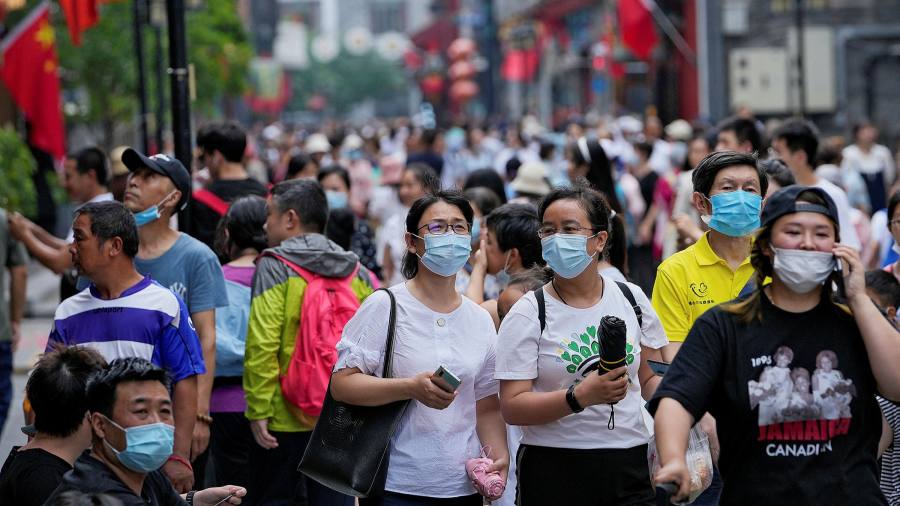The pace of China’s economic recovery rose modestly in the second quarter after signs of sluggishness in the world’s second-biggest economy had stoked expectations of greater policy support.
On a quarter-on-quarter basis, China’s gross domestic product grew 1.3 per cent in the three months to the end of June, up from a revised 0.4 per cent expansion in the previous quarter, the National Bureau of Statistics said on Thursday. Economists had predicted quarter-on-quarter growth of 1 to 1.2 per cent, according to polls by Bloomberg and Reuters.
Second quarter GDP was 7.9 per cent higher than a year earlier, compared with year-on-year growth of 18.3 per cent in the first quarter. The high growth in the first quarter reflected the halt in economic activity in early 2020 after the Covid-19 pandemic erupted in central China and forced the government to impose a nationwide lockdown.
The NBS data release comes at a tense juncture for China’s economic planners as they try to balance financial stability with growth.
Liu Aihua, a spokesperson for the NBS, told reporters in Beijing that the economy had continued to “recover steadily” but warned that the rebound was “unbalanced”.
“We should also be aware that the coronavirus continues to mutate globally and external instabilities and uncertainties abound,” she said.
Signs of downward pressure on China’s recovery have prompted speculation that Beijing will unleash more policy support to shore up business confidence and employment and lift spending.
Issuance of special purpose bonds, used by local governments to fund infrastructure investments, was 50 per cent lower over the first five months of the year, compared with the same period in 2020.
Wang Jun, economist at the China Center for International Economic Exchanges, said the trend was worrying. “Fiscal policy needs to be loosened,” he said. “Local government debt issuance and infrastructure investment are closely related.”
The Chinese government has targeted full-year growth of at least 6 per cent, which most analysts expect will be easily reached as the economic recovery accelerates.
“The annual growth goal is in reach,” said Chaoping Zhu at JPMorgan Asset Management. “However, long-term credit growth has remained weak as the government deploys policies to control leverage.”
Li Keqiang, the Chinese premier, reiterated this week the government’s longstanding pledge to refrain from “flood-like stimulus” measures. Any such loosening threatens to undercut policies introduced to reduce leverage and deal with a series of bond defaults late last year. These problems are especially acute among state-owned enterprises in central and northern provinces, sparking concerns about financial system instability.
China, the first big economy to move out of a lockdown last year, has been watched closely by other economies wrestling with fragile recoveries and the effects of the crisis.
The country’s exports have for much of this year outperformed market expectations, boosted by the US and parts of Europe easing social distancing measures and returning to growth.
But the Covid-19 Delta variant’s rapid spread has cast doubt over external demand in the second half of the year. China has also kept its borders closed as it continues to pursue a “zero-Covid” approach to the pandemic.
Julian Evans-Pritchard, economist with Capital Economics, said China’s pandemic-linked export boom “appears to have peaked”, and noted that on a quarter-on-quarter basis the GDP growth rate was still the fourth weakest since rates were first published in 2010.
“All told, activity in China remained strong,” he said. “But with output already above its pre-virus trend, the economy is struggling to gain ground at its usual pace.”
Manufacturers across Asia have also been blindsided by sharp price increases and sudden supply constraints hitting important resources used by industry. Shipping delays and raw material shortages have also driven fears over disruptions.
According to the NBS, China’s industrial production grew 8.3 per cent year-on-year in June, down from 8.8 per cent in May.
Growth in fixed asset investments, which tracks spending in crucial areas such as infrastructure and property, was up 12.6 per cent year-on-year in the first half of 2021.
Mixed sentiment over China’s domestic consumption has also raised some concerns over the health of the services sector.
Qu Hongbin, HSBC chief economist, expected more “targeted” support for China’s small- and medium-sized enterprises. These businesses account for more than 85 per cent of urban employment and have recovered more slowly compared with other parts of the economy.
“SMEs would be the focus,” Qu said.
Retail sales rose 12.1 per cent in June. That compared with 12.4 per cent in May and 17.7 per cent in April, the NBS data showed, highlighting continued pressure on domestic consumer spending and an uneven economic recovery.
David Chao, global market strategist at Invesco, said segments of the Chinese economy were “being left behind”.
“The retail sales number is perhaps the best indicator of how the common household is doing in China,” Chao said.
Yue Su, principal economist at the Economist Intelligence Unit, added that consumer demand “is still the weak link”.
“China’s GDP data continues to indicate an uneven recovery,” she said. “Retail sales haven’t recovered [and] incomes are not improving as fast as the economy.”
Additional reporting by Xinning Liu in Beijing and Hudson Lockett in Hong Kong

